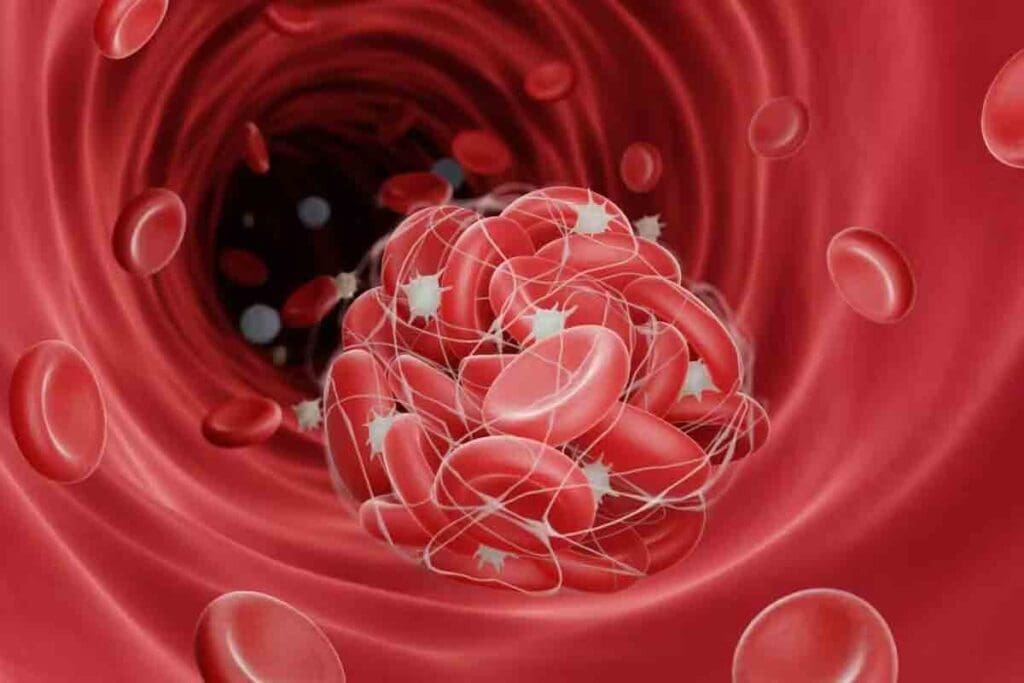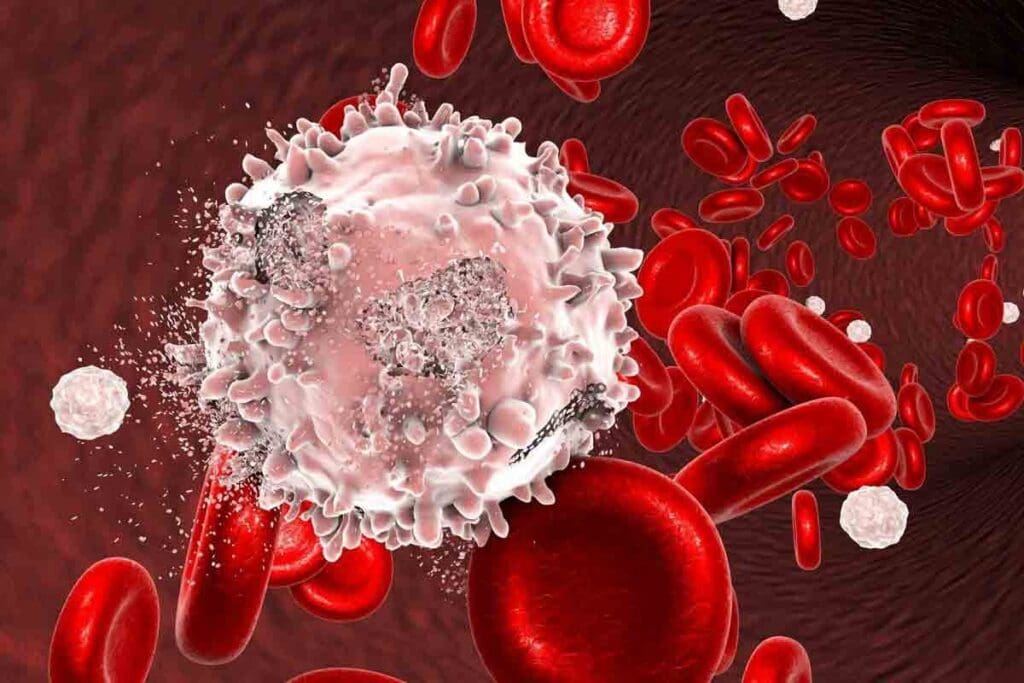Last Updated on November 20, 2025 by Ugurkan Demir

A deficiency in clotting cells, like platelets, is called thrombocytopenia. It happens when there are less than 150,000 platelets in each microliter of blood.
Platelets, or thrombocytes, are colorless blood cells. They help blood clot and stop bleeding by forming clots. Liv Hospital offers top-notch care for this blood condition. They use the latest medical protocols and team up with experts from different fields.

Thrombocytopenia is a condition where there are not enough platelets in the blood. Platelets are key for blood to clot. Knowing about thrombocytopenia is important for doctors and patients.
Thrombocytopenia means having fewer than 150,000 platelets per microliter of blood. It’s called a clotting cell deficiency. A condition with a lack of all blood cells is called pancytopenia, which is more serious.
The usual number of platelets is between 150,000 and 450,000 per microliter. Men are diagnosed with thrombocytopenia at 135,000 platelets per microliter. Women are diagnosed at 157,000 platelets per microliter.
It’s important to know the difference between a normal platelet count and thrombocytopenia. The table below shows how platelet counts are classified:
| Classification | Platelet Count (per microliter) |
| Normal | 150,000 – 450,000 |
| Mild Thrombocytopenia | 100,000 – 149,000 |
| Moderate Thrombocytopenia | 50,000 – 99,000 |
| Severe Thrombocytopenia | Less than 50,000 |
Thrombocytopenia can be primary or secondary, and acute or chronic. This depends on the cause and how long it lasts.

Platelets, or thrombocytes, are tiny blood cells that play a key role in stopping bleeding when a blood vessel is injured. They are vital for blood clotting, or hemostasis. This process involves several steps to stop bleeding and fix damaged blood vessels.
Platelets stop bleeding by sticking together and forming plugs in blood vessel injuries. They stick to the injury site, get activated, and release chemical signals. These signals draw more platelets, creating a platelet plug.
The main roles of platelets in hemostasis include:
The clotting cascade is a complex series of events that leads to a fibrin clot, stabilizing the platelet plug. It involves many clotting factors, proteins found in the blood. The cascade starts through two pathways: the intrinsic and extrinsic pathways, both leading to the common pathway.
The clotting cascade process can be summarized as follows:
A lack of clotting cells, like platelets, can cause bleeding disorders. Knowing how platelets work in blood clotting and the clotting cascade is key for diagnosing and treating a deficiency of clotting cells.
It’s important to know the different types of thrombocytopenia for proper treatment. This condition is when there’s not enough clotting cells. It can happen because of less production, more destruction, or uneven distribution of platelets.
Doctors use many ways to classify thrombocytopenia. They look at how severe it is, what causes it, and how long it lasts. This helps them create the best treatment plan for each patient.
Thrombocytopenia is divided into three levels based on platelet count.
The main difference between primary and secondary thrombocytopenia is the cause.
Thrombocytopenia can also be short-term or long-term.
Knowing these classifications helps doctors give better care for thrombocytopenia. This leads to better results for patients.
Thrombocytopenia is when there’s not enough clotting cells. It can come from many reasons. Knowing these reasons helps doctors find and treat the problem.
One big reason for thrombocytopenia is when the body makes fewer platelets. This can happen because of problems in the bone marrow. For example, aplastic anemia or myelodysplastic syndromes can stop the bone marrow from making enough platelets.
Some medicines, like chemotherapy, can also stop the bone marrow from working right. This leads to fewer platelets. Viruses like HIV or hepatitis C, not enough vitamins like B12 or folate, and toxins can also hurt the bone marrow. This makes it hard for the body to make platelets.
When the body destroys more platelets than it makes, it’s another reason for thrombocytopenia. This can happen when the immune system attacks platelets by mistake. This is what happens in immune thrombocytopenia purpura (ITP).
Some infections, like sepsis, and things like mechanical heart valves or severe burns can also destroy platelets. In these cases, the body uses up platelets too fast.
When platelets get stuck in organs like the spleen, it’s another reason for thrombocytopenia. An enlarged spleen is a common cause. The spleen holds too many platelets, leaving fewer in the blood.
Liver problems and some infections can also cause platelets to get stuck. Finding out why someone has thrombocytopenia is key to treating it right.
Thrombocytopenia is when there’s a deficiency of clotting cells. It can cause many symptoms in different parts of the body. Knowing these symptoms is key for early treatment.
Symptoms of thrombocytopenia include easy bruising and petechiae (small spots on the skin). Some people also get bleeding from small cuts or gums. Others might see purpura (big patches of bruising) and nosebleeds.
“Petechiae, mainly on the lower legs, often show thrombocytopenia,” says a doctor. “These signs happen because there aren’t enough platelets. This makes it hard for the body to stop bleeding.”
If symptoms get worse or don’t go away, see a doctor. Severe thrombocytopenia can cause serious bleeding. This can be very dangerous.
Look for heavy or long menstrual periods, severe bruising, or bleeding that won’t stop. A doctor can help figure out what’s wrong and how to treat it.
Diagnosing thrombocytopenia involves several steps. These include looking at medical history, doing a physical exam, and running lab tests. This detailed approach helps find the exact cause of the condition.
The first step is to gather medical history and do a physical exam. Doctors will ask about symptoms and any past health issues. They also check for signs like bruises or bleeding, which can point to low platelets.
Lab tests are key in diagnosing thrombocytopenia. A complete blood count (CBC) is often the first test. It counts platelets, red blood cells, and white blood cells. A blood smear also checks the shape of these cells. These tests confirm thrombocytopenia and show how severe it is.
For more details on diagnosing and treating thrombocytopenia,
At times, more detailed tests are needed to find the cause of thrombocytopenia. These might include a bone marrow biopsy, tests for autoimmune disorders, or genetic tests. A bone marrow biopsy, for instance, can spot problems like leukemia that lead to low platelets.
With a thorough diagnostic process, doctors can accurately diagnose thrombocytopenia. They then create a treatment plan that fits the patient’s needs.
Thrombocytopenia, a low platelet count, often links to other blood disorders. Knowing these related conditions is key for correct diagnosis and treatment.
Pancytopenia means a lack of all blood cells, including red, white, and platelets. It can stem from bone marrow issues or other problems.
Pancytopenia vs. Thrombocytopenia: Thrombocytopenia is about low platelets. Pancytopenia is a bigger issue, affecting all blood cells. This shows how complex diagnosing and treating these conditions can be.
| Condition | Cells Affected | Common Causes |
| Thrombocytopenia | Platelets | Decreased production, increased destruction |
| Pancytopenia | Red blood cells, white blood cells, platelets | Bone marrow failure, infiltration, fibrosis |
Other disorders can also mess with blood clotting. For example, von Willebrand disease affects clotting due to a lack or problem with von Willebrand factor.
“Von Willebrand disease is the most common inherited bleeding disorder, and it can significantly impact an individual’s quality of life if not properly managed.”
Source: National Hemophilia Foundation
Some conditions can look like thrombocytopenia, making it important to diagnose correctly. Leukemia, for instance, can cause symptoms similar to thrombocytopenia but involves cancerous white blood cells.
It’s essential for doctors to understand these differences. This helps them make the right diagnosis and treatment plan.
Managing deficiency of clotting cells starts with finding and fixing the main problem. It also means making certain health and lifestyle changes. Treating thrombocytopenia well involves looking at the cause, how bad it is, and the patient’s health overall.
The first thing to do is find and fix the main cause. This might mean stopping certain medicines, treating infections or autoimmune diseases, or fixing nutritional issues.
Medical treatments for thrombocytopenia include:
Along with medical care, some lifestyle changes can help with thrombocytopenia. These include:
| Lifestyle Change | Description |
| Avoiding contact sports | To lower injury and bleeding risks. |
| Using soft-bristled toothbrushes | To cut down gum bleeding. |
| Avoiding NSAIDs | Because they can harm platelet function. |
It’s also key to know about medical term for deficiency of all blood cells, or pancytopenia. This is a more serious issue that might need more serious treatment.
Thrombocytopenia is a condition where there’s not enough clotting cells. It’s called thrombocytopenia because the platelet count is too low. This condition needs a full care plan from start to finish.
LivHospital focuses on the patient first. They follow the best medical practices worldwide. They use the latest technology and team up with different specialists to help patients with thrombocytopenia.
Handling thrombocytopenia well means knowing why it happens and treating it right. This way, patients get the help they need. They can then live better and feel better too.
The term for not enough clotting cells is thrombocytopenia.
Thrombocytopenia is when there’s not enough platelets in the blood. Platelets help blood to clot.
Normal platelet counts are between 150,000 to 450,000 per microliter of blood.
Pancytopenia is when there’s a lack of all blood cells.
Thrombocytopenia can happen for several reasons. It might be because of not making enough platelets, losing too many, or they’re not spread out right.
Signs of thrombocytopenia include easy bruising, small spots on the skin, and bleeding from small cuts.
Doctors use a few steps to find out if you have thrombocytopenia. They look at your medical history, do a physical check, and run tests like a CBC and blood smear.
To treat thrombocytopenia, doctors focus on the cause. They might give platelet transfusions, use medicines to help make more platelets, or suggest lifestyle changes.
Platelets are key in stopping bleeding when a blood vessel gets hurt. They help form clots.
The term for not enough clotting cells is thrombocytopenia.
A clotting cell deficiency means you have fewer platelets than normal. This can cause bleeding problems.
Subscribe to our e-newsletter to stay informed about the latest innovations in the world of health and exclusive offers!